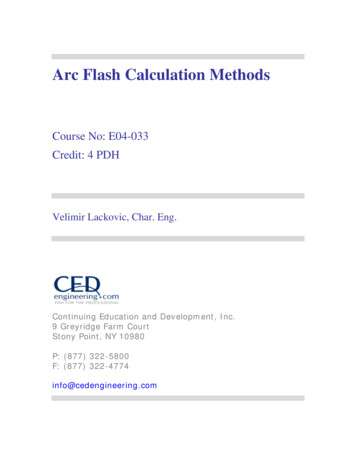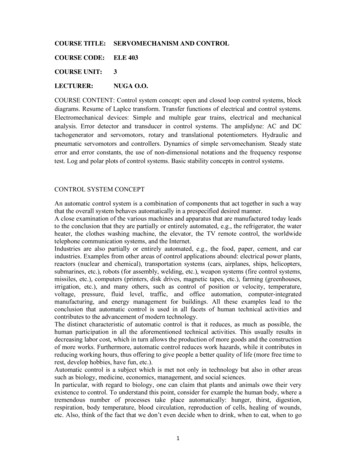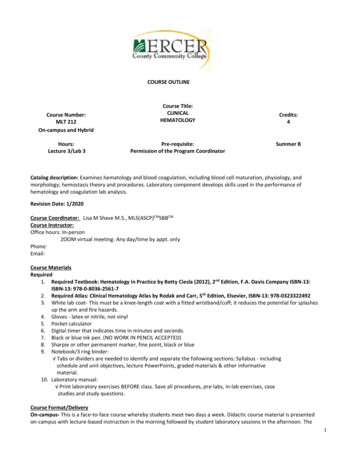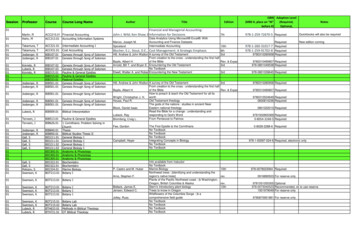
Transcription
Arc Flash Calculation MethodsCourse No: E04-033Credit: 4 PDHVelimir Lackovic, Char. Eng.Continuing Education and Development, Inc.9 Greyridge Farm CourtStony Point, NY 10980P: (877) 322-5800F: (877) 322-4774info@cedengineering.com
ARC FLASH CALCULATION METHODSThis course provides an overview of arc flash hazard computations suggested by IEEEand NFPA. All formulas and calculation procedures presented in this course are theproperty of the IEEE and NFPA. Students are encouraged to consult the standards foradditional details.IEEE STD 1584-2002The listed methods are suggested by IEEE Standard 1584-2002 in the assessment ofarc flash hazard. The empirically derived formulas were developed by IEEE workinggroup on arc flash. These formulas were derived from test results and are applicablefor the below listed conditions.Table 1. Conditions for which the IEEE 1584 formulas are validParameterRangeFrequencies (Hz)50 or 60 HzSystem Voltage (kV)0.208 to 15 kVGap between electrodes (mm) 13 to 152 mmBolted fault current (kA)0.7 to 106 kAGrounding typeUngrounded, grounded, high resistance groundedPhases3 Phase faultsEquipment enclosure typeOpen air, box, MCC, panel, switchgear, cablesSTEP 1: DETERMINE THE ARCING CURRENTFor low voltage electrical systems ( 1 kV), the arc current is determined using formula(1).10. . wherelog is the log10 K V arcing current (kA)-0.153-0.097open configurationbox configurationbolted fault current for three phase faults (symmetrical RMS) (kA)system voltage (kV)(1)
G gap between conductors, (mm)For medimum voltage electrical systems ( 1 kV), the arc current is determined usingformula (2)10.(2)STEP 2: DETERMINE THE NORMALIZED INCIDENT ENERGYThe normalized incident energy, which is derived from 0.2 second arc duration and610 mm arc distance, is determined using formula (3)10. (3)whereincident energy normalized for time and distance (J/cm2) K1 -0.792-0.555open configurationbox configurationK2 0-0.113ungrounded and high resistance grounded systemsgrounded systemsG gap between conductors (mm)STEP 3: EVALUATION OF INCIDENT ENERGYThe normalized incident energy is used to calculate the incident energy at a normalsurface at a specific distance and arcing time using the formula (4).4.184(4).whereE incident energy (J/cm2)Cf Calculation factor 1.0; voltage 1kV 1.5; voltage 1kVt arcing time (seconds)D working distance from arc (mm)x distance exponent as shown in Table 3.2
Table 2. Distance factor (x) for different voltages and enclosure modelsEnclosure Model 0.208 to 1 kV 1 to 15 kVOpen air22Switchgear1.4730.973MCC and Panels1.641Cable22STEP 4: FLASH PROTECTION BOUNDARYThe flash protection boundary is the distance at which staff without personal protectiveequipment (PPE) may suffer second-degree injuries that can be cured. It is given withformula (5).610 4.184.(5)whereDB Cf distance of the boundary from the arcing point (mm)calculation factor 1.0; voltage 1 kV 1.5; voltage 1 kVEn normalized incident energyEB incident energy at the boundary distance (J/cm2); EB can be set at 5.0 J/cm2(1.2 cal/cm2) for bare skint arcing time (seconds)x the distance factor from Table 2Ibf bolted fault current (kA)PROTECTION BOUNDARIES SET BY NFPA 70E - FLASH PROTECTIONBOUNDARYSerious burns caused by arc flash can happen within this boundary unless adequatePPE is used.-Staff within this boundary must wear adequate PPE regardless of their task.-The distance from the arc source at which the on-set of a second degree burn
happens. 1.2 Cal/cm² 0.1 sec. is conceived as a second degree burnthreshold.-Medical treatment may still be needed if bare skin is brought out to this level offlash. Complete recovery is anticipated.LIMITED APPROACH BOUNDARYLimited approach boundary sets a boundary around brought out live parts that maynot be violated by “unqualified” staff unless followed by “qualified” staff.-May be nearer than flash boundary.-Determined exclusively on the nominal voltage.RESTRICTED APPROACH BOUNDARYRestricted approach boundary is boundary near brought out live parts that may beviolated only by “qualified” staff using adequate shock prevention methods and tools.-Concern is a shock hazard.-Determined exclusively on the nominal voltage.PROHIBITED APPROACH BOUNDARYA shock protection boundary to be violated by only “qualified” staff using the sameprotection as if direct contact with live part is projected. Determined exclusively on thesystem nominal voltage.NFPA 70E - ARC FLASH BOUNDARYThe theoretical maximum arc power in MW is half the bolted 3-phase fault MVA. Thishappens when the arc current is 70.7% of the bolted fault current. Starting from this,the flash protection boundary is computed as (6):2.65 1.732 (6)
where V Ibf t distance of the boundary from the arcing points (inches)rated system voltage L-L (kV)bolted fault current (kA)arcing time (seconds)NFPA 70E - INCIDENT ENERGYArc in open air – 0.6 kV or less, 16-50 kA short circuit current5271.0.0016 0.0076 0.8938Arc in box – 0.6 kV or less, 16-50 kA short circuit current1038.7.0.0093 0.3453 5.9675Arc in open air – Higher than 0.6 kV793whereE incident energy (cal/cm2)Ibf bolted fault current (kA)t arcing time (seconds)D working distance from arc (inches)NFPA 70E - ANNEX C METHODTable 3. Formulas for arc in box for computing arc current, incident energy and flashprotection limitsV 1kV1kV V 5kVV 5kVIa 0.850.9280.004.E 21.816.5416.DB 16.5 /1.2 .21.8 /1.2416 /1.2The formulas in Table 3 are only applicable to arc in box for short circuit currents in0.6 kA and 106 kA range.where
E incident energy (cal/cm2)Ibf bolted fault current (kA)Ia arc current (kA)t arcing time (seconds)D working distance from arc (inches)DB separation of the flash protection boundary from the arcing point (inches)NFPA 70E TABLES - FLASH PROTECTION BOUNDARYNFPA 70E presents a simple method of assessing flash protection boundary. This ispresented in Table 4. Information shown in this table is an estimate – the actual arcflash limits may depend upon different factors such as available fault level and tripsettings of the upstream protective equipment. Hence, information shown in this tableis not suggested for use.Table 4. Assessment method for determining flash protection boundary as per NFPA70E-2003 ROPArc LocationSystem Voltage Flash Protection Boundary (feet)Arc in Air200 to 1000 volts4Arc in Enclosure 200 to 1000 volts10Arc in Enclosure 1000 volts and up20CATEGORY CLASSIFICATIONS OF THE HAZARD/RISKThe NFPA 70E proposes the option of using Table 220.6(B)(9)(A) Hazard RiskCategory Classifications. Information in this table does not give the flash protectionlimit, but only sets the hazard/risk category number. The Table 220.6(B)(9)(A) alsodefines the need of V-rated gloves and V-rated devices and tools. The categorizationof risk class is based on several elements such as voltage, type of devices, type oftask to be executed, available short circuit current, circuit breaker tripping time or fuseclearing time and the location of the enclosure doors. The different types of taskpresented in the table are: controlling circuit breakers or fuses, working on live
elements, voltage testing, taking out and putting in bolted covers, using safetygrounds, working on control circuits, etc.An example of what NFPA 70E Table 220.6(B)(9)(A) may look like is presented fortwo items in Table 5: operating on live elements and voltage testing. The accurateshort circuit currents for three phase bolted faults can be determined using commercialsoftware packages. A basic estimate presented in NFPA 70E – 2003 is utilizing theupstream transformer information in the following equation (7). The accurate shortcircuit current will be less than this determined value due to the system impedance ofthe upstream to transformer.(7)%whereISC 3-phase bolted fault levelMVA Base rated MVA of the upstream transformerV line to line voltage at the transformer secondary side%Z impedance of the transformer (percentage)Table 5 (a). Hazard / Risk Category Classification for Working on Live Parts - NFPA70EEquipmenttypeEquipmentsidePanel BoardMCC 0.6 kVClassLoad Sideof kA)42 10 3665FaultClearingTime (s)0.24kV0.030.030.10.0310 1042526562761020.030.030.20.10.330.20.10.277to 0.6kV12211445552.3to7.2kV1to38kV
EquipmenttypeEquipmentsideBusBusSwitchgear 0.6kV ClassOther Equipment0.6 kV ClassNEMA E2 MotorStarters MV,Metal CladSwitchgear, MVOther EquipmentShortCircuitCurrent(kA) 10 1035FaultClearingTime (s)0.24kV0.277to 0.6kV0.10.330.5344425265 65550.330.20.10.354442.3to7.2kV1to38kV555Table 5 (b). Hazard / Risk Category Classification for Voltage Testing - NFPA 70EEquipmenttypeEquipmentsidePanel BoardMCC 0.6 kVClassLoad Sideof Breaker/FuseBusBusBusBusBusBusBusBusSwitchgear 0.6ShortCircuitCurrent(kA)42 10 3665FaultClearingTime (s)0.24kV0.030.030.10.031 104252656276102 10 10350.030.030.20.10.330.20.10.10.330.50.277to 0.6kV12212222221122.3to7.2kV1to38kV
aultClearingTime (s)0.24kV0.277to 0.6kV425265 65550.330.20.10.352222.3to7.2kV1to38kVkV ClassOther Equipment0.6 kV ClassNEMA E2 MotorStarters MV,Metal CladSwitchgear, MVOther Equipment255ARC BLAST PRESSUREAnother point linked with an electric arc is the blast energy or pressure. This hazard isnot addressed in NFPA 70E or IEEE Standard 1584. This power can be substantialand can blow staff away from the arc inducing falls and hurts that may be more seriousthan burns. Being pushed away from the arc cuts down the staff exposure to the heatradiation and molten copper, but can expose the staff to falls or impact traumas. Therough initial impulse force at 24 inches was determined to be roughly 260 lb/ft2 asfound from the formula (8) below. .wherePressure is in pounds per square footD Distance from arc in feetIarc Arc current in kA(8)
PRACTICAL PROCEDURE TO ARC FLASH COMPUTATIONSFew methodologies for arc flash computations are proposed NFPA 70E. Calculationsare usually performed by electrical engineers, since an apprehension of the shortcircuit phenomena of power systems is required. If the available short circuit figures atdifferent devices and the related fault clearing times are known, then a qualified personcan also complete the arc flash hazard assessment (AFH) by using the adequateNFPA 70E tables. Nevertheless, this method has major disadvantages due to largeoversimplification inherent in this method. For larger electrical systems with moregeneration sources and various operating patterns, it is preferred to complete acomprehensive engineering assessment that can find the worst-case arc flash hazardsituation that can happen. As yet remain to be seen, this will not inevitably be theconditions with the greatest fault level.The next procedure is used in comprehensive arc flash calculation. Prior to beginningthe data gathering, it should be decided upon which computation methodology will beused.1. Distinguish all locations/devices for AFH computation.2. Data Gathering:a. Device information for short circuit calculations: voltage, size (MVA/kVA),impedance, X/R ratio, etc.b. Device information for protective device features: device type, existing settings forrelays, breakers and trip elements, rating amps, time-current curves, total clearingtime.c. Device information for arc flash calculations: device type, enclosure type (open air,box, etc.), gap between conductors, grounding arrangement, number of phases andestimate of working distance for the devices.d. All electrical power system devices, their existing arrangements and potentialalternative arrangements.
3. Develop a single-line diagram of the electrical system.4. Complete short circuit calculations:a. Determine bolted (available) three-phase fault current for each device.b. Determine every contributing branch/load current.5. Determine estimated arc current:a. Determine arc current using empirical method (NFPA, IEEE, etc.).b. Determine branch currents contributing to the arc current from every branch.6. Determine arcing time from the protective device features and the contributing arccurrent going through this equipment for every branch that importantly adds to the arcfault.7. Determine the incident energy for the device at the given working distances.8. Find out the hazard/risk category (HRC) for the approximated incident energy level.9. Determine the flash protection limit for the device.10. Write down the findings in reports, single-line diagrams and with adequate labelson the devices.STEP 1 – RECOGNITION OF LOCATIONS/DEVICES FOR AFHArc flash hazard study is required only for those locations where staff is exhibited tothe risk. Hence, it may not be required to complete the study for each and every devicein the electrical system. Panels and switchboards rated 208 volts or less can usuallybe neglected if the service transformer is less than 125 kVA.The potential arc will not probably be sustainable at lower voltages and smaller faultcurrents. All panels with breakers and fuses should be considered in the study if there
is possibility for major arc flash injury. Incidents may happen when handling thebreakers or fused disconnects, even with the panel door closed. Existing single-linediagrams can be consulted for deciding the device that call for study. If single-linediagram does not exist, it should be made.STEP 2 –EQUIPMENT DATA GATHERING FOR SHORT CIRCUIT ASSESSMENTEven though some devices may not call for arc flash hazard study, information aboutthis device may be needed in a short circuit assessment. Distinctive informationneeded for the study is shown in Table 6. Short circuit assessment needs informationon utility, generators, transformers, cables, transmission lines, motors, etc. Devicename-plate can give most of the necessary information. In the absence of specificinformation, it may be possible to get the data from the manufacturers. Also, distinctiveinformation can be assumed by citing books. Power system software tools usuallyhave broad library of manufacturer’s information including most electrical devicesTable 6. Typical data needed for equipment for short circuit analysisDescriptionDataEquipment TypeVoltageMVA/KVAImpedanceX/R RatioPhases/connectionDEVICE INFORMATION FOR PROTECTIVE DEVICE CHARACTERISTICSCollect information on the different protective devices that will decide the arcing time.Table 7 presents what kind of data is needed. This information may be collected fromexisting drawings, relay calibration information, protective device coordination studiesand from field inspection. Collect the time-current characteristics (TCC) for thesedevices from the manufacturers.Decide if the protective device is reliable enough. This can be completed by askingthe operators, or by testing. Some companies have occasional relay testingprocedures. If the protective element is deteriorating, the information given by themanufacturer may not be useful. If the fault interruption does not happen as
anticipated, then the arc flash study cannot be precise. It will be essential to repair orreplace such device.Table 7. Necessary protective device informationProtective Device Data to GatherBreakerType, fault clearing time, pickup setting, delay curve, delaysettingRelayType, CT ratio, pickup (tap) setting, delay type (curve) andsetting (time dial)FuseType, amp rating, voltage, peak let-through currentDEVICE INFORMATION FOR ARC FLASH ASSESSMENTDepending on the selected computation methodology, the following device data isneeded for an arc flash hazard assessment.Table 8. Device data for AFH assessmentDescriptionDataType of enclosure (open air, box, etc.)Gap between exposed conductorsGrounding typePhases/ConnectionWorking DistanceThe working distance is an estimate measure that should be based on the type of workbeing completed and the device type. It may vary depending on the manufacturer’sdesign and work principles. Working distances should be attested for different workpatterns and devices as part of an overall safety program.FIND OUT ALL POSSIBLE OPERATING PATTERNSDocument all possible arrangements using single line diagrams. The circuitbreaker/switch/fuse position may change during contingency service. Parallel feedscan largely increase the fault current levels and resulting arc flash hazard. Thecontribution of associated motors to the fault level will also increase the hazard. Studyshould take into account both the normal operating condition as well as the worstpossible arc flash condition. In principle, the higher the available fault short circuitcurrent, the higher the arc flash energy. Nevertheless, since arc flash energy is a
function of the arc duration as well as the arc current, it cannot be mechanicallyaccepted that the greatest fault current will always be the worst-case AFH.STEP 3 – COMPLETE SINGLE-LINE DIAGRAMSingle-line (one-line) diagrams are useful tools for recording and communicatingpower systems data. They are easy to read, present the connections and condition ofdevices and contain information needed for assessment. The assessment findingssuch as short circuit studies and arc flash hazard assessment can be presented onthe single line diagrams. Majority of the plants should already have single-linediagrams. The accuracy of these has to be checked before starting the study. If a newsingle line diagram is needed, it can be made using the collected information. Studyusing commercial integrated software asks for information entry to build a powersystem model. Major software tools provide an advanced graphical drag and-dropsingle-line diagram totally incorporated with short circuit, protective devicecoordination, and arc flash study. These tools give an easy way to make, update andmaintain your power system single-line in accordance with NFPA-70E rules.STEP 4 – SHORT CIRCUIT CALCULATIONSComplete instructions on completing short circuit assessment are not part of thiscourse. But more considerations linked to AFH when completing short circuitcalculations are briefly presented in the following sections. Only 3-phase short circuitcurrents are looked at when completing AFH. This may seem strange, but it is uniformwith the recommendations in IEEE-1584 and NFPA-70E. There are few reasons forthis. One is that 3 phase short circuit currents typically give the greatest possible shortcircuit energy and can be considered as the worst-case.Another crucial argument is that experience has shown that arcing faults in devices orair that begin as line-to-ground faults, can very rapidly step up into 3-phase faults asthe air ionizes across phases. This advancement from single-phase to 3-phasetypically happens within a few cycles. Because of this, majority of the tests completedon arc flash energy has been based on 3-phase short circuit currents. For singe-phasesystems, IEEE-1584 suggests that computations are done for the same 3-phasesystem and says that this will yield conservative findings. Based on the collected
information for different system operating conditions, arc flash assessments should becompleted for each possible condition. When completing short circuit computations todecide on maximum short circuit current level, conservative guesses and assumptionsare implemented. This makes sense if the objective is to decide on the maximumbreaker or device duties. Nevertheless, for AFH, using too conservative short circuitinformation can yield non-conservative findings since a very high fault current maydevelop very short arc duration due to the operation of instantaneous trip devices. Thehighest fault current does not inevitably mean the highest possible arc flash hazardsince the incident energy is a function of arcing time that may be an inverselyproportional function of the arcing current. For AFH calculations, short circuitcomputations should be conservative, but not too conservative.COMPUTING BOLTED FAULT CURRENTCompute the 3-phase bolted fault current in symmetrical rms amperes for all buses ordevices, and for each potential operating condition. Verify for the following whileconceiving different interconnections at the concerned bus or device:-Numerous utility sources that may be switched in or out of operation.-Multiple local generator sources that are run in parallel or isolated dependingon the system arrangement.-Emergency operating conditions. This may be with only small backupgeneration.-Maintenance conditions where short circuit currents are low but arc durationmay be long.-Parallel lines to Switchgear or MCC’s.-Tie breakers which can be serviced open or closed.-Large motors or process sections not in service.A short circuit/arc flash scenario should be determined for each operating condition.
This can be a complex task for most software or spreadsheet calculators. Handcalculations and spread sheet calculators usually neglect the transient short circuitinformation that last for a few cycles. These are greater than the sustained short circuitvalues. The generator and motor transients during the fault add to the arc fault. Totake these into account:Consider sub-transient and transient impedances of the generators in order to find thebolted short circuit current if the arcing time is small. For long arcing times, use thesustained short circuit figures. This implies an iterative technique, since the arcing timedepends upon the fault current going through the upstream protective device. Takeinto account contribution of connected motors.COMPUTE CONTRIBUTING BRANCH SHORT CIRCUIT CURRENTSContributing branch currents to total faults are computed to determine the contributingarc currents by different branches that are used to determine the trip times of theprotective devices on the branches. The protective device upstream to the fault canregister only the current going through it. The short circuit current may be higher thanthe current going through the upstream protective device. Hence, the total short circuitcurrent cannot be used to determine the trip time unless other branch currents areimportantly smaller than the upstream current. Likewise, for parallel lines, thecontributing currents from each line must be computed to decide the trip time. Specialattention is required when calculating branch currents through transformers. Thiscould be one of the common source of errors since the branch current needs to beadapted by the transformation ratio. When a fault happens on the low voltage side ofa power transformer, the protective device on the high voltage side of the transformerregisters a smaller current due to the transformer turns ratio.STEP 5 – CALCULATE EXPECTED ARC CURRENT VALUECOMPUTE ARC CURRENTCompute arc current for each device or bus using one of the empirical equationsaccepted by the NFPA-70E (NFPA, IEEE, or other standards). The arc current maybe a function of the bolted fault current, the open circuit voltage, the type of enclosure
and the gap between conductors.RANGE OF ARC CURRENT/TOLERANCE DUE TO VARIATION BASED ON IEEE1584To account for the variation that can happen in arcs, IEEE methodology proposes thefollowing.1. Compute the maximum anticipated bolted fault condition.2. Compute the minimum anticipated bolted fault condition. The minimum bolted faultcurrent could be a light load condition with motor loads or generators out of service.3. Compute the arcing current at 100% of IEEE 1584 approximation for the above twoscenarios.4. Compute the arcing current at 85% of IEEE 1584 approximation for the two abovescenarios.5. At these four arcing currents compute the arc flash incident energy and utilize thegreatest of the incident energies to determine PPE. The minimum fault current mayneed longer to clear and could end in a greater arc flash incident energy level than themaximum-fault current condition. The short circuit current in the main fault currentsource should be found since the current in this equipment may influence the faultclearing time for the great part of the arc flash incident energy.Even though IEEE suggests considering a range of 85% to 100% of the approximatedarc current, IEEE test data suggests that the evaluated values of arc current differ from67% of the approximation to 157% of the approximation. Careful use of tolerances isneeded for the following reasons:1. The operating time of inverse-time protective elements is determined by the arccurrent.2. The incident thermal energy is more sensitive to arcing time than it is to arccurrent.
3. A more realistic and fairly conservative judgement of arcing time can be foundby accurate selection of tolerances of arc current.The following section gives guidelines based on statistical assessment of testinformation for different voltage levels and enclosure models.TOLERANCE DUE TO VARIATION BASED ON REAL INFORMATIONDue to the random nature of arc currents, the real arc current may take any valuewithin a range of values. The computed arc current is only a single approximationwithin the range. The computed arc current or the greatest potential arc current maynot inevitably cause the largest incident energy to which staff may be exposed. Thearcing time may depend upon the arc current due to the tripping features of theprotective element. Hence, the incident energy may be higher for smaller arc currentsif the contributing branch fault current of the arc current lies in the inverse-time sectionof trip characteristics.Table 9. Minimum and maximum tolerances for arc current obtained from IEEE 1584test data for confidence level of 95%Voltage Enclosure Type Minimum Arc Current Maximum Arc %10.2%MVBox-20.8%12.3%When taking into account the range of the computed arc current, the easiest way is totake a tolerance. This tolerance is a percentage of the computed arc current. Thetolerance is found from statistical assessment of the test information. The tolerancesdissent for IEEE 1584 method and NFPA 70E methods. Table 9 gives tolerances forIEEE 1584 arc current estimate for a confidence level of 95%. A confidence level of95% entails that there is a probability of 95% that the arc current will be in the tolerancerange. To be more conservative, confidence level of 99% can be taken. This wouldextend the tolerance range.
EXAMPLEFor a 0.48 kV devices in open air, the calculated arc current (Iarc) using IEEE 1584estimate was 50 kA. What is the potential range of the arc current? From Table 9 theminimum and maximum margins of arc current are –26.5% and 26% respectively.Minimum arc current Iarc*(100 Min.Tolerance %)/100 50*(100-26.5)/100 36.75 kAMaximum arc current Iarc*(100 Max Tolerance %)/100 50*(100 26.0)/100 63 kAVARIATION OF ARCING CURRENT WITH ARC GAPIf the precise arc gap (or gap between conductors) was utilized in determining the arccurrent approximations, then additional modifications need not be used. Nevertheless,if the gap is mean value or an assumed figure, then the potential range of arc currentmay need to be corrected. The gap is utilized in computations in the IEEE 1584formulas. NFPA 70E does not take the gap into consideration. Table 10 gives thesensitivity of arc current to gap. For every mm of difference in gap the arc current figureis changed by the sensitivity amount. The voltage across an arc gap is approximatelyrelative to the length of the gap. Greater voltage means greater arc power for the samearc current. Since the arc resistance is non-linear, the resistance is not directly relativeto the gap length. Hence, the statistical approach is favoured in the assessment of theeffect of fluctuation of arc gap length on arc current. The method presented belowshould be utilized only for small differences in arc gap, as with most other sensitivityassessments.Table 10. Sensitivity of arc current to gap for IEEE 1584 methodologyVoltage Enclosure Sensitivity (%/mm)LVBox-1.0%LVOpen-0.7%MVNot Required
EXAMPLEThe accurate gap between conductors for different elements is not known. For lowvoltage box, it was discovered that the gap varied from 25 mm to 40 mm with anaverage of 32 mm. There are two possible ways to cope with this. The first way is toget two approximations for arc current, one for the least gap and the other for thegreatest gap. The second way is to adapt the IEEE approximation for the mean gapusing the sensitivity presented in Table 10. Let us assume that the arc current for 32mm gap was found to be 50 kA.Arc current for min. gap Iarc*(1 sensitivity*(Min.gap-Average gap)/100) 50*(1-1.0*(25-32)/100) 53.5 kAArc current for max. gap Iarc*(1 sensitivity*(Max.gap-Average gap)/100) 50*(1-1.0*(40-32)/100) 46 kAIf the variation in gap is small, then extensive assessment need not be carried out.LIMITATIONS FOR ARC CURRENTSAfter computing the range of potential arc current, it is required to verify if the computedfigures are within the practical range. Verify for the following:-Upper limitation: It is not feasible for the arc current to be higher than the boltedfault current due to the additional impedance of the arc. Hence, after employingcorrections for random variations and for gap variations, if the upper limit of therange of arc current is higher than the bolted fault current, then cast away thatfigure and take the bolted fault current as the upper limitation.
EXAMPLEFor a bolted fault current of 50 kA at medium voltage equipment in box, the arc currentwas determined to be 49 kA using IEEE 1584 formulas. To consider randomvariations, tolerance data from Table 9 were used. This takes the upper limit of arccurrent to 12.3% higher than the approximated figure. Hence, the upper limit of the arccurrent was determined to be 49*(100 12.3)/100 55 kA. This is higher than thebolted fault current (50 kA), and hence, is not possible. Take the upper limit of arccurrent as 50 kA.-Lower Limit: Arcs do not hold when the current is very low. For 480-voltelect
upstream transformer information in the following equation (7). The accurate short circuit current will be less than this determined value due to the system impedance of the upstream to transformer. Ì ¼ L @ Æ Ï º » Ô æ Ø. ; 7 6 Ï A @ 5 4 4 % A (7) where ISC 3-phase bolted fault level MVA Base











